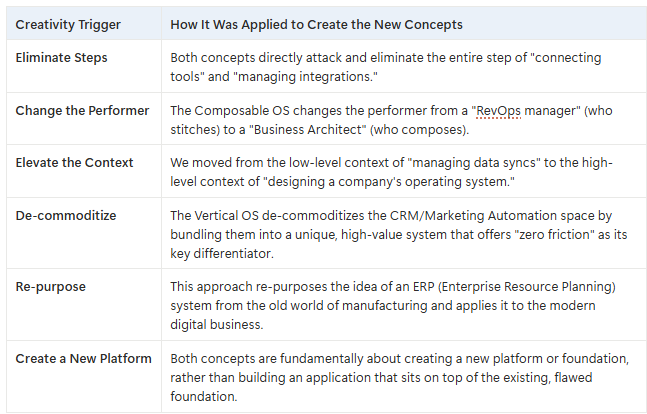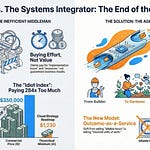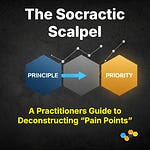Investors are rewarding companies for patching a broken system. Here’s a detailed blueprint for building a company that replaces it entirely.
The $17 Million Misconception
When a Y-Combinator alum like Gumloop announces a $17 million Series A, the startup world takes notice. The headlines write themselves: "No-code automation is heating up," "The API economy is booming," "Businesses are desperate to connect their sprawling software stacks." And on the surface, this all makes perfect sense. Gumloop is building a slick, powerful platform to help companies automate the flow of information between their tools. They're solving an obvious, painful problem.
But what if I told you that this entire category of "workflow automation"—from Zapier to Make to Gumloop—is built on a foundational flaw? What if this $17 million investment isn't funding a revolution, but is instead bankrolling the creation of a more elegant band-aid for a self-inflicted wound?
The entire premise of workflow automation rests on one giant, unquestioned assumption: that the chaotic, fragmented, and disconnected way we use software is a permanent state of affairs. These companies are in the business of profiting from the chaos. They sell you the shovels and buckets to bail out your sinking boat, but they never ask if you should be in that boat in the first place.
This post is a deep dive into that question. We're going to apply a rigorous set of strategic tools to deconstruct the very problem Gumloop thinks it's solving. Then, from the ground up, we'll reconstruct a new, vastly more valuable solution. Finally, we'll architect a strategic playbook for building a truly defensible, category-defining company.
This isn't just a critique of one startup. It's a critique of a mindset—prevalent in accelerators and boardrooms—that prioritizes solving immediate, obvious problems over questioning the broken systems that create them. Let's begin.
Part 1: Deconstruction - Identifying the Foundational Crack in the SaaS Universe
The Premise We All Accept: App Chaos is Normal
Before you can challenge a premise, you have to understand it. Gumloop's world is the world most of us live in. Your company has a "stack." You have Salesforce for your CRM, HubSpot for marketing, Slack for communication, Google Sheets for random analyses, Stripe for payments, and a dozen other specialized SaaS tools.
Each of these tools is "best-in-class" at its specific function. But they don't talk to each other. Data gets trapped in silos. Your marketing team doesn't know what the sales team is doing. Your finance team has to manually pull reports from five different systems. It's operational chaos.
Into this chaos comes the hero: the workflow automation platform. With a few clicks, you can build a "loop": when a new lead comes into HubSpot, create a new record in Salesforce, and send a notification in Slack. Problem solved, right? The friction is gone.
But we're not thinking from first principles. We're accepting the current reality as a given. To get to the truth, we have to start asking some uncomfortable questions.
Challenging the Premise with Socratic Questioning
Socratic questioning is a disciplined process of stripping away assumptions to get to foundational truths. Let's apply it to the core premise of workflow automation.
You: Why do you need a tool like Gumloop? Founder: Because we need to connect our apps. Our data is siloed.
You: Okay, why is your data siloed? Founder: Because we use different apps for different functions. We have HubSpot for marketing and Salesforce for sales.
You: Why do you use two different apps for marketing and sales, which are part of the same go-to-market function? Founder: Well, each is considered 'best-of-breed' for its specific purpose. We wanted the best tools for the job.
You: Let's examine that. Is the 'job' to use HubSpot or is the 'job' to generate and convert qualified leads? Is the goal to have the 'best' CRM, or is the goal to run your revenue-generating operations effectively and predictably? Founder: ...The goal is to run the business, obviously.
You: And does stitching together a dozen 'best-of-breed' tools, and then paying for another tool to connect them, actually help you run the business more effectively? What are the hidden costs of this approach—the time spent building and maintaining automations, the cost of data errors when a sync fails, the strategic disadvantage of never having a single, real-time view of your customer? Founder: The costs are high. It's a constant headache.
You: So, the problem isn't just that your apps are disconnected. The problem might be that your entire operational strategy—built on a foundation of fragmented, specialized tools—is fundamentally flawed. You've optimized for features at the tool-level, but you've created massive friction at the system-level.
This line of questioning reveals the first foundational crack. The need for workflow automation is a symptom of a deeper strategic choice: the decision to build a business on a patchwork of disconnected software.
Finding the Root Cause with the Five Whys
Now let's get specific. Let's trace the pain of a user—a Revenue Operations (RevOps) Manager at a scaling tech company—to its true source using the Five Whys.
Her stated goal: "I need to build an automation in Gumloop to sync new qualified leads from HubSpot to our sales team's Salesforce instance and create a deal."
Why do you need to sync leads from HubSpot to Salesforce?
"Because marketing generates leads in HubSpot, but the sales team lives in Salesforce. They need the data there to work the deals." (This is the surface problem Gumloop solves.)
Why do the sales and marketing teams live in different systems for the same customer journey?
"Because each platform has specialized tools the teams prefer. But the real goal is to ensure a smooth handoff of lead data so sales can act quickly and with full context."
Why is a smooth, contextual handoff so critical?
"Because if there's a delay or data is missing, our speed-to-lead suffers and conversion rates drop. We need to provide our sales reps with perfect information to improve their performance."
Why do you need to improve their performance and conversion rates?
"Because we need to make our revenue growth more predictable. My job is to eliminate operational friction that creates uncertainty in our forecast."
Why do you need predictable revenue growth?
"Because that is the ultimate measure of a healthy, scalable business. It allows us to make confident decisions about hiring, investment, and strategy. It's the core outcome my role is meant to support."
Look at that journey. We started at a technical task—"syncing data"—and ended at a fundamental strategic outcome—"achieve predictable revenue growth."
Gumloop is a fantastic solution to Why #1. But it does nothing to solve Whys #2 through #5. It accepts the broken operational model (separate systems) as a given and simply greases the wheels. The real, high-value problem isn't the technical gap between tools; it's the strategic gap between the company's current operations and its desired outcome of a predictable, scalable business model.
Part 2: Reconstruction - Building a Solution for the Real Job-to-be-Done
Now that we've deconstructed the problem to its core, we can throw away the old assumptions and rebuild from a new foundation. To do this, we'll use the Jobs-to-be-Done (JTBD) framework.
Moving Beyond "Features" to "Jobs"
JTBD theory posits that customers don't "buy" products; they "hire" them to get a job done. A "job" is the progress a person is trying to make in a given circumstance. It's a statement of a desired outcome, completely divorced from any potential solution.
The "job" here is not "I need to connect app A to app B." That's a description of a task, a solution-centric view. The real, high-level job, as we discovered in our Five Whys analysis, is much deeper.
Defining the Real Job
Based on our deconstruction, we can craft a powerful, high-level Job Statement for the RevOps manager and the founder who hired her:
"When we are trying to scale our company, give me a single, reliable command center for our core go-to-market operations, so I can empower my team with a unified source of truth and give leadership a predictable forecast, without the constant cost and complexity of stitching together dozens of disparate software tools."
This job statement is a blueprint for innovation. It's a north star. It contains no mention of "integrations" or "workflows." In fact, it implicitly asks for their elimination. A solution that gets this job done perfectly wouldn't just be a better Gumloop; it would make Gumloop and its entire category irrelevant.
Envisioning a Job-Centric Future: Two Novel Approaches
If you're solving that job, what do you build? You innovate at a higher level of abstraction. You don't build another tool for the toolbox; you redesign the entire workshop.
The Vertical Operating System (Working Today, Underleveraged)
This approach isn't science fiction; it's happening right now in industries outside of the tech bubble. Companies like ServiceTitan (for home services) and Toast (for restaurants) have become multi-billion dollar giants by building a single, all-in-one platform that runs the entire business. A plumber using ServiceTitan doesn't need to "sync" their scheduling app with their dispatching app, their CRM, and their payment processor. It's all one thing. The "workflow" is simply the natural, seamless operation of the platform.
Why hasn't this happened for digital-native businesses? The conventional wisdom is that tech companies are too diverse in their needs. But are they? A B2B SaaS company's go-to-market motion is remarkably standard: generate leads, qualify them, work deals, close them, support customers, and bill them.
A "Vertical OS for SaaS" would bundle a tightly integrated CRM, marketing automation platform, customer support desk, and billing system into one coherent product. It wouldn't have the feature depth of Salesforce in every single category, but it wouldn't need to. Its core product performance metric isn't "more features"; it's "zero friction." It wins by eliminating the integration problem entirely. It gets the whole job done.
The Composable Operating System (The Future)
This is a more forward-thinking, but potentially even more powerful, concept. What if we elevated the abstraction layer even further?
In this model, a company wouldn't buy monolithic "apps" at all. Instead, it would subscribe to modular "business capabilities" from a marketplace, all built upon a shared, unified data layer. You'd acquire a "Lead Management" capability, an "Invoicing" capability, and a "Customer Support Ticketing" capability. Each of these components is headless, API-first, and natively interoperable because they all read from and write to the same underlying data model.
The "user interface" could be a lightweight, customizable front-end, or it could even be Slack or a command line. The "app" becomes disposable. The data and the business logic are the core asset.
In this world, the concept of "workflow automation" is nonsensical. It's like needing a special tool to make sure the words you type in a Google Doc also appear on the screen. The system is designed for coherence from the ground up. This is the ultimate end-state: a business that can compose and recompose its operational stack on the fly without ever creating a data silo.
Creativity Triggers Analysis
These concepts aren't pulled from thin air. They are the result of applying specific innovative patterns to the job-to-be-done.
Part 3: Evaluation & Strategy - Architecting an Unbeatable Business Model
A brilliant concept is useless without a strategy to bring it to life and defend it. Now we'll evaluate our reconstructed solution and design a tactical plan to build a defensible moat.
Step 1: Choose a Defensible North Star (The Organic Growth Paths Framework)
Not all growth is created equal. The Organic Growth Paths framework helps us choose a strategic direction that leads to defensible, long-term value.
Gumloop's Path: Improve an Existing Product. Gumloop is fundamentally making a better, perhaps more user-friendly, version of Zapier. This places them on a path of direct, feature-for-feature competition in a bloody red ocean. Their only moat is speed of execution and product performance—the weakest and least durable form of advantage.
Our Reconstructed Path: Core Market Disruption / Create a New Platform. The "Vertical Operating System" is a textbook example of Core Market Disruption. It targets the core customers of existing incumbents (Salesforce, HubSpot, etc.) with a new, highly integrated solution that fundamentally changes the value equation. It competes not on features, but on the elimination of system-level friction. The "Composable OS" goes even further, aiming to Create a New Platform that would become the foundation for a new ecosystem of business software.
By consciously choosing one of these latter paths, you're not just deciding on a product; you're deciding to play a different game entirely—one that's harder to start but far easier to win in the long run.
Step 2: Execute the Strategy with Doblin's 10 Types of Innovation
A strategy is just a wish until you have tactics to execute it. Doblin's 10 Types of Innovation is a tactical playbook for building a multi-layered, defensible moat. A great company never innovates in just one area. Let's use this framework to build a fortress around our "Vertical OS for SaaS" concept.
Configuration (The Engine of the Business)
Profit Model: Instead of a simple per-seat, per-month fee, you could pioneer an outcome-based model. For example, pricing could be a small percentage of the revenue managed through the platform. This aligns your success directly with your customer's success, creating a powerful partnership.
Network: Create a certified ecosystem of implementation partners and consultants who specialize in migrating companies off their fragmented "best-of-breed" stacks and onto your unified OS. This creates a network effect and a sales channel simultaneously.
Structure: Organize your company not around products (CRM team, Marketing team), but around customer jobs ("Revenue Predictability Team," "Customer Lifecycle Team"). This internal structure would reinforce your external promise of a seamless, job-centric solution.
Process: Develop a proprietary, highly automated data migration and onboarding process that makes it incredibly easy for a customer to switch. This process becomes a core, patented asset that reduces friction and locks in customers.
Offering (The Product Itself)
Product Performance: The key performance metric isn't the number of integrations, but the lack of them. The platform's superiority comes from its speed, reliability, and the seamlessness that is only possible in a unified architecture.
Product System: This is the heart of the moat. You offer a suite of tools—CRM, marketing automation, support desk, analytics—that are good enough on their own but magical together. The cross-product synergy creates incredibly high switching costs. Leaving your platform would mean rebuilding an entire operational nervous system from scratch.
Experience (How You Reach and Serve Customers)
Service: Offer white-glove "systems consolidation" as a service. You're not just selling software; you're selling a strategic transformation from chaos to coherence. This high-touch service justifies a premium price point.
Channel: Bypass the IT managers and self-serve funnels that dominate SaaS. Build a direct, consultative sales force that sells to the COO and CFO—the people who feel the strategic pain of operational chaos and can sign a six-figure check to make it go away.
Brand: Build a brand that stands for something bigger than software. You're not selling features; you're selling "SaaS Sanity," "Operational Coherence," or "The End of App Chaos." It's a movement against the status quo.
Customer Engagement: Foster a community not for "power users" of a specific tool, but for "systems thinkers"—the operations leaders who are designing the next generation of companies. This builds a loyal tribe and a powerful feedback loop.
This multi-layered moat is a fortress. A competitor can't just copy a feature to beat you. They'd have to copy your entire business model, your process, your brand, and your ecosystem. That's a defensible business.
The Accelerator Blindspot and the Founder's Choice
Gumloop is building a good company. It's a logical solution to an obvious problem, executed well. Their investors will likely get a decent return. But it’s a company operating in a local maximum. Its success is predicated on the continued existence of a broken system.
The true, 100x, category-defining opportunity doesn't lie in patching that system. It lies in replacing it.
This reveals a fundamental blindspot in the accelerator model. The intense pressure for rapid growth and clear, demonstrable traction in a 3-month cycle inherently favors ideas that solve immediate, obvious problems. It incentivizes founders to build on top of existing platforms and user behaviors—to create a better shovel for a known gold rush. It discourages the slower, harder, more abstract work of first-principles thinking that asks, "Why are we digging for gold here in the first place?"
This kind of foundational innovation looks strange at first. It's harder to explain in a pitch. Its initial market is less clear. It requires educating customers, not just acquiring them. It's a harder path.
But it's the only path that leads to building something truly new, truly valuable, and truly defensible.
So, the choice is yours. Are you building a business that profits from the chaos, or are you building one that brings the clarity? Are you patching the old world, or are you architecting the new one? The answer will define your legacy.
Follow me on 𝕏: https://x.com/mikeboysen
If you're interested in inventing the future as opposed to fiddling around the edges, feel free to contact me. My availability is limited.
Mike Boysen - www.pjtbd.com
De-Risk Your Next Big Idea
Masterclass: Heavily Discounted $67
My Blog: https://jtbd.one
Book an appointment: https://pjtbd.com/book-mike
Join our community: https://pjtbd.com/join












